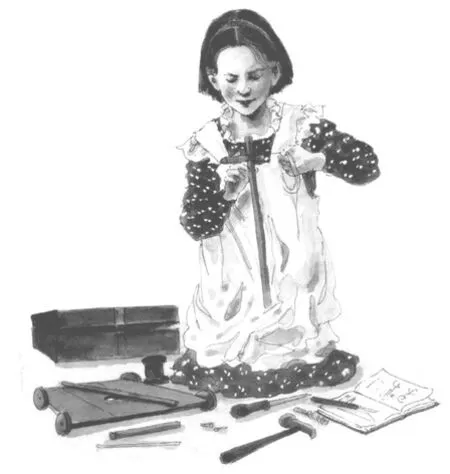纸袋的发明,女权的胜利
文/哈德利·霍尔·米尔斯译/黄青
纸袋的发明,女权的胜利
文/哈德利·霍尔·米尔斯译/黄青

我们经常用纸袋装东西,无论是杂物、衣服、礼物、垃圾还是酒水。小学四年级之前,我都会将午饭放进纸袋带到学校,因为妈妈会用贴纸和绘画来装饰我的纸袋。圣诞节来临时,人们将沙子和蜡烛装进纸袋做成灯照亮街区。体育迷们心生怨气时还会将纸袋套在头上。不过,有多少人了解平底纸袋的由来呢?又有多少人知道纸袋的发明意味着女权战胜男权,智慧打败霸道呢?
We carry stuff in them—groceries, clothes, gifts, trash and booze1booze〈非正式〉酒精饮料。. I carried my lunch to school in one until the fourth grade because my mother would decorate them with stickers2sticker贴纸。and drawings. People add sand and candles to them to illuminate3illuminate照亮。their neighbourhoods at Christmas. Disgruntled4disgruntled不满的;不高兴的。sports fans cover their heads with them. But how many people know where the fl atbottomed paper bag came from? Or that its invention was a triumph of feminism over patriarchy5patriarchy父权制;男权政治。and of brains over bullying6bullying恃强欺弱的行为。?
[2]根据多数历史记载,人们过去使用皮革、木材、棉花和芦苇来制作容器。以前,纸张都是依靠手工一张一张制作的,堪称奢侈品,只供少数文化人用于书籍、记录和信件。1799年,法国发明家路易-尼古拉·罗伯特获得卷纸制造机的专利。这一发明使得纸张进入大量生产的阶段。商人不久即使用卷纸,或曰“锥形纸袋”,来包装少量商品。意料之中的是,效果不尽人意。他们还曾制作简陋的手工纸袋,但是这一过程比较费时,往往也不成功。
[2] For most of recorded history, containers were made of leather, wood, cotton and reeds7reed芦苇属植物。. Paper, made by hand one sheet at a time, was a luxury, used only for books, records and letters by the literate8literate能读会写的;受过教育的。few. In 1799, a French inventor named Louis-Nicolas Robert was granted a patent for a machine that produced rolls of paper. This invention brought paper to the masses. Soon, merchants were using rolled paper, or “cornucopias9cornucopias锥形纸袋。”, to package small quantities of goods, with predictably messy10messy复杂的,麻烦的。results. They also constructed rudimentary11rudimentary简陋的;原始的。paper bags by hand, which was a timeconsuming and not always successful process.
[3]各厂商竞相打造既结实耐用又易于生产的纸袋。1852年,美国人弗兰西斯·沃勒获得纸袋制造机的首个专利。这种机器利用蒸汽和浆糊来生产信封形状的纸袋。沃勒发明的机器得到推广,但是它生产出的纸袋不仅笨重,而且用途有限——不难想象,将大量杂物放进硕大信封模样的纸袋中会是什么样子。不过,毕竟有胜于无,生产纸袋的工厂日益增多。1860年代晚期,玛格丽特·奈特来到位于马萨诸塞州斯普林菲尔德的克伦比亚纸袋公司工作。这个身材高挑的新英格兰人不缀钻研,工作勤勉,短短几年内,她充满创造力的设计就给这一行业带来了一场革命。
[3] The race was on to produce a paper bag that was both sturdy12sturdy结实的。and easy to make. In 1852, the American Francis Wolle received the first patent for a paper-bag machine. It used steam and paste to create bags in the shape of envelopes. Though the machine became popular, the bags it produced were cumbersome13cumbersome不方便的。and of limited use—picture a load of groceries in a large envelopeshaped sack. Still, they were better than nothing at all, and factories producing the bags multiplied. In the late 1860s, Margaret Knight, a tall, endlessly inquisitive14inquisitive好学的;好奇的。and hard-working New Englander, went to work for the Columbia Paper Bag Company in Springfield, Massachusetts. Within a few years, her ingenious15inge-nious有创意的;巧妙的。designs would revolutionise16revolutionise彻底改变;完全变革the industry.
[4]奈特生于1838年,她的童年深受工业革命的影响。乍看起来,她的人生经历就是一个典型的悲情故事:由寡居的母亲抚养长大,10岁就被迫到新罕布什尔环境严苛的棉纺厂工作。但这个没有读过书的工人自幼就头脑敏锐,富有创造精神。尚未成年时,她曾经目睹一个工友因纺织机钢头机梭弹出受伤。为防止类似事故重演,她发明了梭盖,并被所在工厂采用。1872年,在接受进步刊物《妇女杂志》采访时,她曾回忆起自己与众不同的童年:
小时候,我对女孩子通常喜欢的东西没有一点兴趣;洋娃娃对我也毫无吸引力。我看不出珍爱这些毫无面部表情的陶瓷娃娃有什么意义。我想要的只是一把折刀、一柄螺丝锥和一些木头。朋友们有些害怕。他们都叫我假小子,但我对此不以为然。我有时会叹气,因为自己和其他女孩不一样;但我还算明智,认识到没有办法改变,只能从我的工具中寻找更多慰藉。我总是为哥哥弟弟做这做那,他们想要任何玩具,都会说:“玛蒂会给我们做的。”我做的风筝小有名气,雪橇也让镇上所有男孩既羡慕又佩服。
[4] Born in 1838, Knight’s childhood was shaped by the industrial revolution. At first glance, hers is the classic victim’s story—raised by a widowed mother, and put to work by the age of 10 in the brutally inhospitable17inhospitable不好客的;冷淡的。cotton mills of New Hampshire. But from her earliest days this uneducated labourer had an agile18agile敏捷的。, inventive mind. While still a child, Knight saw a fellow worker injured when a steel-tipped shuttle19shuttle梭子。shot off a loom20loom织布机。. She soon created a shuttle cover to prevent any more accidents, and her invention was adopted by her factory. In an interview with the progressiveWoman’s Journalin 1872, she recalled her unconventional21unconventional不因循守旧的;(人、态度、行为等)非传统的。youth:
As a child, I never cared for things that girls usually do; dolls never possessed any charms for me. I couldn’t see the sense of coddling22coddle娇养;悉心照料。bits of porcelain with senseless faces: the only things I wanted were a jack-knife23jack-knife大折刀, a gimlet24gimlet螺丝锥。, and pieces of wood. My friends were horrified. I was called a tomboy25tomboy假小子,行为似男孩的顽皮姑娘。; but that made very little impression on me. I sighed sometimes, because I was not like the other girls; but wisely concluded that I couldn’t help it, and sought further consolation26consolation安慰。from my tools. I was always making things for my brothers; did theywant anything in the line of playthings, they always said: “Mattie will make them for us.” I was famous for my kites; and my sleds27sled雪橇。were the envy and admiration of all the boys in town.
[5]奈特进入哥伦比亚纸袋公司时只是一名底层员工。此前几年,30多岁仍未成家的奈特成了一个“多面手”,在银版照相、摄影、雕刻、房屋维修和室内装潢等方面都算得上行家。整日泡在工厂里的她,很快听说工厂正尝试研制可以高效生产平底纸袋的机器。她在日记中写道:“我了解到目前还没有所谓的平底纸袋机器,所以我打算不断尝试,直到找出办法为止。”没有工厂帮助,老板也不知情,在这种情况下,奈特开始专心致志地研究这个问题。
[5] By the time she joined the Columbia Paper Bag Company as a lowly28lowly地位低的;无足轻重的。factory worker, the 30-something, unmarried Knight had spent years as a “Jill-of-all-trades”, becoming proficient in daguerreotype29daguerreotype银版照相法。, photography, engraving30engraving雕刻;雕刻术。, house repair and upholstering31upholster(用家具)布置;给(沙发等)做软垫(或布面等)。. Spending long hours at the factory, she soon heard of current efforts to create a machine that could efficiently manufacture flat-bottomed paper bags.“I am told that there is no such machine known as a square-bottomed machine,”she wrote in her journal. “I mean to try away at it until I get my ideas worked out.” Independent of the factory and without her bosses’ knowledge, Knight began to study the issue intently.
[6]1867年,她潜心研制能够“自动裁剪、折叠和粘贴纸袋底部”的机器。奈特每天工作到深夜,以至于寄宿公寓的管家都说:“我看到她一直在画图……全是那个机器的草图。我觉得她心无杂念。”连在工厂上班的时候她也放不下这个工作。起初此举曾惹怒主管,直到奈特向他们展示了自己的计划后,他们才相信“她的目光比厂里任何男人都更为敏锐”。先是这一机器的“摇摇晃晃”的木制模型机取得成功,生产出数以千计“优质美观的袋子”,之后铁制机器又于1868年问世。当这台机器在波士顿商店进行改良的时候,恰好被查理斯·F.安南看到,后来安南居然声称是他的发明,其人品值得怀疑。
[6] By 1867, she was hard at work on creating a machine that could “cut, fold and paste bag bottoms itself”. Her work kept her up at night, leading the manager of her boarding house to declare: “I saw her making drawings continually… always of the machine. She has known nothing else, I think.”Her work on the machine also bled into32bleed into渗透进。her shifts at the factory. This initially annoyed her superiors—until she showed them her plans—which led them to believe that she had a “keener eye than any man in the works”. After a“rickety” wooden model of her machine proved successful, producing thousands of “good, handsome bags”, she had an iron version produced in 1868. While the machine was at a Boston shop to be re fi ned, it was viewed by Charles F Annan, a would-be-inventor of dubious33dubious有问题的,靠不住的。morality.
[7]奈特准备为新机器申请专利。1871年,她吃惊地发现该机器的专利权已经授予安南,而且安南也声称这个机器属于自己。这场纠纷最终闹上法庭。囊中羞涩的奈特雇用了专利律师证明她才是这台机器真正的发明者,律师费每天100美元。安南的律师辩称,一个没有接受过教育、完全依靠自学的女人绝无可能制造出如此精密的机器。但是在每一个回合,奈特都会出示大量的物证和目击者的证词进行反击。奈特反驳说:“自我记事起,我就和机器结下了不解之缘。”尽管官员们禁不住责备奈特拖延太久,没有尽早申请专利,但专利专员最终还是站在奈特这一边。因为奈特不是“生意人”,这一疏忽也得到了谅解。
[7] Knight prepared to apply for a patent for her new machine. In 1871, she was shocked to fi nd that Annan had already been granted a patent to the machine, which he claimed as his own. The dispute ended up in court, where the cash-strapped34cash-strapped资金短缺的。Knight spent $100 a day to hire a patent attorney to prove that she was the machine’s true inventor. Annan’s lawyer argued that an uneducated, self-taught woman could never have built such a sophisticated machine. He was countered35counter反驳。at every turn by the mountains of physical evidence and eyewitness testimony36testimony〈法律〉证词,证言。Knight produced. “I have from my earliest recollection37recollection回忆。been connected in some way with machinery,”Knight protested. In the end, the commissioner of patents found in favour of Knight, though of fi cials could not resist chastising38chastise训斥。her for waiting so long to apply for her patent. However, since Knight was not a “man of business”, this oversight39oversight疏忽。was forgiven.
[8] 1871年 7月 11日,奈特以“新型改良纸袋生产机”获得专利,专利号为116842。不久以后,她与一个合伙人创立了东方纸袋公司。新机器可以完成30个工人的工作量,奈特也因这一革命性的机器成为媒体的宠儿。很快,大型百货商店和杂货店都纷纷开始采用这种可竖立的平底纸袋,维多利亚女王也授予奈特皇家荣誉勋章。1883年,联合纸袋机器公司的查尔斯·史迪威在奈特专利的基础上,用自己发明的机器改进了纸袋的品质,所生产的可以折叠的开口式平底纸袋一直沿用至今。
[8] On 11 July 1871, Knight was granted patent number 116,842 for her“new and improved machine for making paper bags”. She soon formed the Eastern Paper Bag Company with a partner, and became a media darling for her revolutionary machine, which did the work of 30 labourers. The new stand-alone40stand-alone独立的。, fl at-bottomed bags were quickly adopted by large department stores and grocers, and Knight was awarded a royal honour from Queen Victoria. In 1883, Charles Stilwell of the Union Paper Bag Machine Company, working from Knight’s patent, further advanced the paper bag with his invention of a machine that produced the Self-Opening-Sack (SOS), the pleated41pleated打褶的;有褶的。fl at-bottomed bags that are used today.
[9]一家报纸将“女爱迪生”的称号送给活力四射的奈特。奈特将自己的余生都奉献给了发明。1914年,奈特与世长猝,享年76岁。2006年,奈特进入造纸业国际名人堂。至此,据估计全世界每年要使用约250亿个纸袋。
[9] The vivacious42vivacious(常指女性)活泼的。Knight, dubbed43dub把……称为。by one paper the “lady Edison”, would spend the rest of her long life—she died aged 76 in 1914—inventing. By 2006, when she was inducted44induct进入;正式授予。into the Paper Industry International Hall of Fame, it was estimated that around 25 billion paper sacks were used annually throughout the world.
[10]奈特是女性发明家群体的典型代表,其他女发明家还有雨刷发明者玛丽·安德森、无反光玻璃发明者凯瑟琳·布洛杰特和防弹背心发明者斯特凡妮·克沃勒克。她们在男性主宰的行业乃至世界中创造了改变生活的发明。她们的故事意义深远,值得广为传颂。这些女发明家的故事能够鼓舞新一代的女孩和年轻女性去动手,去实验,去创造。 □
[10] Knight is emblematic45emblematic标志的;象征(性)的。of a whole multitude46multitude大量。of female inventors, such as Mary Anderson (the windshield47windshield挡风玻璃。wiper), Katharine Blodgett (non-reflective glass), and Stephanie Kwolek48美国波兰裔女化学家,Kevlar(凯夫拉尔)纤维的发明者。凯夫拉尔最知名的用途是用来制作防弹背心,因而克沃勒克也被称为“防弹纤维之母”。(Kevlar), who created lifechanging inventions within industries—and a world—dominated by men. Their stories are important and should be better known. They can inspire future generations of girls and young women to tinker49tinker修补;粗修。, experiment and invent.
The Invention of the Paper Bag Was a Triumph of Feminism
ByHadley Hall Meares
(译者单位:中央民族大学外国语学院)

